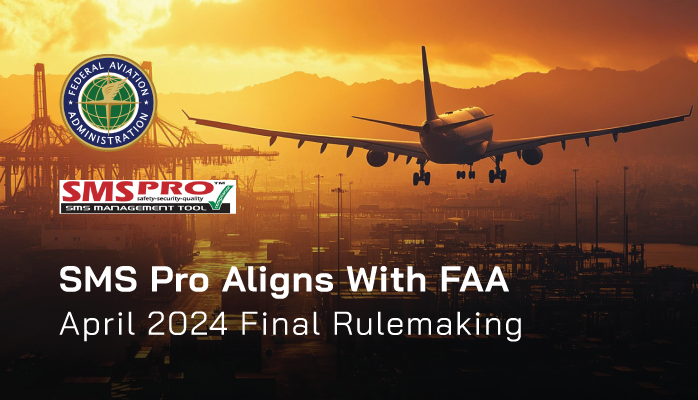SMS Pro Aligns With FAA April 2024 Final Rulemaking

The Federal Aviation Administration (FAA) has updated the Safety Management System (SMS) requirements for Part 121 operators under 14 CFR Part 5, as outlined in the April 2024 final rulemaking.
These updates introduce specific requirements aimed at enhancing safety through improved
- ethical standards,
- system interfaces,
- hazard reporting, and
- recordkeeping.
Below, I detail each cited regulation, its requirements, and how SMS Pro’s widely used aviation safety management software, aligns with or satisfies these requirements based on its features and capabilities.
Part 5 Regulatory Requirements and SMS Pro Alignment
1. § 5.21(a)(7) – Safety Policy Code of Ethics
Requirement:
This section mandates that Part 121 operators include a code of ethics in their SMS safety policy. The code must outline ethical standards for employees, emphasizing integrity in safety-related decision-making and reporting. It aims to foster a culture where safety is prioritized, and employees are encouraged to report hazards without fear of reprisal. The accountable executive and management are responsible for ensuring compliance with this code, which should be documented and communicated across the organization.
How SMS Pro Satisfies§ 5.21(a)(7):
SMS Pro includes modules for Safety Policy Management, allowing operators to document and disseminate their safety policy, including a code of ethics. The software enables:
- Documentation: Operators can create and store a formal code of ethics within the SMS Pro platform, ensuring it is accessible to all employees.
- Communication: The Safety Communication module (aligned with § 5.93) supports distributing the code of ethics through newsletters, bulletins, or training materials, ensuring employees understand their ethical obligations.
- Accountability: SMS Pro’s Organizational Management tools allow operators to define roles and responsibilities, linking the accountable executive and management to the enforcement of the code. Audit trails track policy acknowledgments, ensuring compliance.
- Cultural Integration: The software’s reporting and training modules reinforce a just culture, encouraging ethical behavior by integrating the code into hazard reporting workflows.
By providing a centralized platform for policy creation, communication, and tracking, SMS Pro ensures the code of ethics is a living component of the SMS, meeting § 5.21(a)(7).
In your SMS Pro portal, refer to
- Policy >> Policies & Procedures
- Policy >> Duties & Responsibilities
- Safety Promotion >> Message Board
- Safety Promotion >> Newsletters
2. § 5.53(b)(5) – Safety Risk Management Interfaces
Requirement:
This regulation requires operators to consider interfaces between their operations and external entities (e.g., vendors, contractors, or other certificate holders) during system analysis and hazard identification. Understanding these interfaces is critical for identifying hazards that arise from interactions, such as maintenance performed by a Part 145 repair station or code-share operations. The analysis must focus on aviation safety impacts, ensuring risks are proactively managed across organizational boundaries.
How SMS Pro Satisfies § 5.53(b)(5):
SMS Pro’s Safety Risk Management (SRM) module is known internally as PHAT (Proactive Hazard Analysis Tool). PHAT is designed to support comprehensive system analysis, including external interfaces:
- Hazard Identification: The software allows operators to map operational processes and identify hazards, including those stemming from external interfaces (e.g., data sharing with maintenance providers or operational handoffs with code-share partners).
- Risk Assessment Tools: SMS Pro provides risk matrices and assessment workflows that incorporate interface-related hazards, enabling operators to evaluate severity and likelihood across system boundaries.
- Collaboration Features: The platform supports data sharing and communication with external entities through secure portals, ensuring interface-related hazards are tracked and mitigated collaboratively.
- Scalability: For complex operations, SMS Pro’s customizable workflows allow operators to model interfaces specific to their operational environment, ensuring compliance with § 5.53(b)(5).
By facilitating structured analysis of external interfaces, SMS Pro helps operators meet the requirement to integrate these considerations into their SRM processes.
In your SMS Pro portal, refer to
- Risk Management >> Proactive Hazard Analysis Tool (PHAT)
- Safety Assurance >> Vendor Management
- Setup >> Customize Settings…Initial tab (to select internal interfaces)
Screenshot of Issue Manager’s Classify tab demonstrating implemented risk controls and related interfaces based on hazard classification
3. § 5.57 – Hazard Notification
Requirement:
This section mandates that operators establish processes to notify interfacing persons or organizations (e.g., other certificate holders, vendors, or regulators) about identified hazards that affect aviation safety. The process must ensure timely communication of hazards to those who need to act, such as a maintenance provider informed of a recurring aircraft issue. Records of these notifications must be retained per § 5.97(d).
How SMS Pro Satisfies § 5.57:
SMS Pro’s Issue Reporting and Issue Manager modules directly supports hazard notification:
- Automated Notifications: The software allows operators to configure workflows that automatically notify relevant internal and external stakeholders (e.g., via email or portal alerts) when a hazard is identified.
- Customizable Workflows: Operators can define notification protocols based on hazard type, severity, or interfacing entity, ensuring compliance with § 5.57’s requirement for timely communication.
- Integration with SRM: Hazard notifications are linked to the SRM process, ensuring that identified risks trigger appropriate notifications as part of the risk management workflow.
- Recordkeeping: SMS Pro automatically logs notifications, including recipient details and timestamps, satisfying the record retention requirements tied to § 5.97(d).
SMS Pro’s ability to streamline and document hazard notifications ensures operators meet § 5.57’s requirements efficiently.
Related SMS Pro Modules: See § 5.53(b)(5) – Safety Risk Management Interfaces immediately above this section to see SMS Pro’s modules that satisfy this requirement, as they are related.
4. § 5.71(a)(7) – Employee Confidential Reporting System

Requirement:
Operators must implement a confidential employee reporting system where employees can report hazards, incidents, or safety concerns without fear of reprisal. This system is critical for fostering a just culture and ensuring proactive hazard identification. The system must protect employee confidentiality and allow for reporting of proposed solutions or safety improvements.
How SMS Pro Satisfies § 5.71(a)(7):
SMS Pro’s Confidential Reporting module is a core feature designed to meet this requirement:
- Anonymity and Confidentiality: The software supports anonymous or confidential reporting options, ensuring employees can submit reports without fear of retaliation.
- User-Friendly Interface: Employees can access the reporting system via web or mobile platforms, lowering barriers to reporting hazards or concerns.
- Feedback Loop: SMS Pro allows employees to propose solutions within their reports, which are then routed to safety managers for review, aligning with the regulation’s emphasis on safety improvements.
- Data Security: Robust encryption and access controls protect reporter identities, ensuring compliance with confidentiality requirements. For additional security SMS Pro’s Secure Workflow module allows ASAP participants to deidentify reported issues before releasing information to the Event Report Committee for safety risk management procedures.
By providing a secure, accessible, and confidential reporting platform, SMS Pro fully supports § 5.71(a)(7).
In your SMS Pro portal, refer to:
- My Safety >> Submit New Issue;
- Risk Management >> Issue Manager;
- Risk Management >> Secure Workflow Manager (optional add-on module)
5. § 5.71(a)(8) – Investigating Hazard Notifications
Requirement:
Operators must establish processes to investigate hazard notifications received from internal (e.g., employee reports) and external sources (e.g., other certificate holders or regulators). Investigations must be systematic, feeding results back into the SMS’s safety assurance and risk management processes to assess risks and implement controls. This ensures hazards are not just reported but actively addressed.
How SMS Pro Satisfies § 5.71(a)(8):
SMS Pro’s Investigation and Corrective Action features aligns with this requirement:
- Investigation Workflows: The software provides structured templates for investigating reported hazards, guiding safety teams through root cause analysis and risk assessment.
- Integration with SRM and SA: Investigation results are automatically linked to the SRM process (§ 5.53) for risk assessment and the Safety Assurance process (§ 5.71) for performance monitoring, ensuring a closed-loop system.
- External Source Handling: SMS Pro allows operators to log and track hazards received from external sources, assigning them to investigation workflows with the same rigor as internal reports.
- Audit Trails: The software maintains detailed records of investigations, including actions taken and outcomes, supporting compliance with § 5.97(d).
SMS Pro’s investigation tools ensure that all hazard notifications are thoroughly addressed, meeting § 5.71(a)(8).
In your SMS Pro portal, refer to:
- My Safety >> Submit New Issue;
- My Safety >> Public Issue Reporting (for external stakeholders)
- Risk Management >> Issue Manager;
6. § 5.97(d) – SMS Records

Requirement:
Operators must retain records of communications related to hazard notifications (per § 5.57) for a minimum of 24 consecutive calendar months. This includes records of notifications sent to interfacing entities and any related correspondence. These records must be accessible to demonstrate SMS compliance during FAA oversight.
How SMS Pro Satisfies § 5.97(d):
SMS Pro’s Recordkeeping and Documentation module is designed to meet FAA recordkeeping requirements:
- Automated Record Storage: The software automatically archives all hazard notification communications, including emails, portal messages, and internal notes, with timestamps and metadata.
- Retention Compliance: SMS Pro allows operators to set retention periods (e.g., 24 months for § 5.97(d)), ensuring records are retained as required and automatically purged afterward to comply with data management policies.
- Audit-Ready Access: Records are organized and searchable, enabling operators to quickly provide evidence of compliance during FAA inspections.
- Integration: Records are linked to related SRM and SA processes, providing a comprehensive audit trail for hazard notifications.
SMS Pro’s robust recordkeeping ensures compliance with § 5.97(d)’s retention and accessibility requirements.
In your SMS Pro portal, refer to:
- Risk Management >> Issue Manager;
- Setup >> Customize Settings…Company Info tab (to set data retention preferences)
Additional Notes on SMS Pro and Compliance
- Scalability: SMS Pro is designed to be scalable, accommodating the needs of both large Part 121 operators and smaller organizations. This aligns with the FAA’s emphasis on scalable SMS implementation, reducing compliance costs for operators with existing safety programs.
- Voluntary Programs Integration: SMS Pro supports integration with voluntary programs like ASAP and ASIAS, which the FAA recognizes as useful for meeting SMS requirements (though not mandated). This enhances compliance with § 5.71’s data collection and analysis requirements.
- Training and Promotion: SMS Pro’s Training Management module supports § 5.91 by ensuring employees are trained on SMS processes, including the code of ethics and reporting systems. Its Safety Promotion tools (e.g., dashboards, reports) align with § 5.93, fostering a safety culture.
- FAA Oversight: SMS Pro’s audit and reporting features allow operators to generate compliance reports for FAA inspectors, streamlining oversight and validation of the updated SMS requirements.
Critical Considerations
While SMS Pro is a powerful tool, its effectiveness depends on proper implementation:
- Customization: Operators must configure SMS Pro to reflect their specific operational environment, including interfaces and hazard notification protocols.
- Training: Employees and safety managers need training to use SMS Pro effectively, ensuring all features (e.g., confidential reporting, investigation workflows) are fully utilized.
- Continuous Improvement: Operators must regularly review SMS Pro data to identify trends and improve processes, aligning with § 5.75 (Continuous Improvement).
- Data Protection: Given concerns about SMS data disclosure (e.g., FOIA or litigation), operators should leverage SMS Pro’s security features to protect sensitive information, though the FAA provides limited protections for voluntarily submitted data.
Conclusion
SMS Pro satisfies the updated FAA Part 5 requirements for Part 121 operators by providing integrated modules for
- policy management,
- risk management,
- hazard reporting,
- investigation, and
- recordkeeping.
Its features align directly with §§ 5.21(a)(7), 5.53(b)(5), 5.57, 5.71(a)(7), 5.71(a)(8), and 5.97(d), offering tools to
- document a code of ethics,
- analyze interfaces,
- notify hazards,
- manage confidential reporting,
- investigate hazards, and
- retain records.
By leveraging SMS Pro’s automation, scalability, and audit-ready capabilities, operators can efficiently revise their SMS to meet these requirements while fostering a proactive safety culture.
For specific implementation guidance, operators should consult SMS Pro’s support resources or contact the FAA SMS Program Office at 9-NATL-SMS-ProgramOffice@faa.gov





